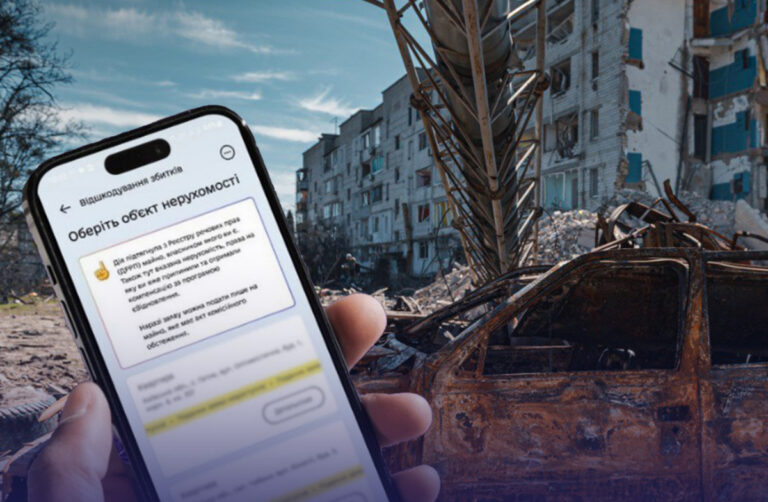
Remote Assessment and Compensation for Destroyed Housing: How the Updated “eRecovery” Program Works
Since July 2025, the “eRecovery” program has introduced new rules that are particularly important for those whose homes were destroyed or completely demolished as a result of hostilities.
The Cabinet of Ministers of Ukraine has approved a mechanism that allows damaged property inspections to be carried out remotely even if the property is located in an active shelling zone. This decision opens the door to compensation for people who previously could not obtain confirmation of destruction because commissions could not safely travel to the site.
“We must ensure that people do not risk their lives just to take a photo of their destroyed home,” explains the Ministry for Communities, Territories, and Infrastructure Development. “Now it is enough to provide materials that confirm the fact of destruction, and the commission will conduct the inspection remotely.”
How to Apply for Compensation
1. Submit an information notice
The first step is to submit an information notice about the destroyed property. This can be done:
- via the Diia mobile application or web portal;
- at any Administrative Service Center (CNAP);
- through a notary authorized to accept such documents.
2. Submit a compensation application
Next, you submit an application for compensation indicating the selected format:
- Housing certificate a document that allows you to purchase another home to replace the destroyed one;
- Monetary compensation a payment to rebuild on your own land located in a safe zone (available only to private homeowners).
At present, both options can be applied for through the Diia app, reducing processing time and avoiding unnecessary travel.
3. Determining the inspection format
The local commission assesses the security situation in the area and decides whether it is possible to conduct an on-site inspection or if a remote inspection is required.
4. Remote inspection
This may involve:
- satellite imagery;
- drone footage;
- photos and videos taken by the applicant using a mobile device.
Requirements for such materials:
- images must be color, clear, and distortion-free;
- ideally, files should contain date, time, and geolocation;
- the entire plot of land and at least three different angles of the property must be shown;
- damaged load-bearing structures (walls, roof, ceilings) must be visible;
- where possible, identifying markers should be included (address plates, house numbers, signs, other landmarks).
5. Commission decision
Within 30 calendar days of submitting the application, the commission must decide:
- if sufficient evidence is provided compensation is granted;
- if evidence is lacking the review may be suspended. In that case, the applicant has 90 days to submit additional materials.
What Has Changed for Suspended Applications
The new rules provide for the automatic resumption of review for applications suspended due to the impossibility of conducting an on-site inspection.
Now, the commission can use remote tools. The application status in Diia will change from “Suspended” to “In progress”.
If this does not happen, you should contact the commission directly.
Post List
Legal Aspects to Note
From a legal perspective, these changes mean:
- Expanded evidence base: acceptable proof now includes not only on-site inspection reports but also remote materials;
- Adaptation of procedures to martial law: the government applies the principle of proportionality minimizing risks to citizens while maintaining legal guarantees;
- Changed procedural role of commissions: they act not only as assessors but also as coordinators of evidence collection from multiple sources (the applicant, police, emergency services, military).
Recommendations for Applicants
- Do not risk your life for photos if the area is under fire, use materials from official services or eyewitnesses.
- Document the destruction thoroughly: the more high-quality shots from different angles, the faster the commission can approve your case.
- Keep photo metadata enable geolocation and date stamps in your phone settings.
- Use official submission channels the Diia portal or app to fix the official submission date.
- Check your application status if it has not been resumed automatically after the new rules, submit a written request.
Real-life Examples
- A family from Chernihiv region received a housing certificate after the commission used NASA satellite images and footage from the State Emergency Service. An on-site visit was impossible due to mine hazards.
- A homeowner in Kherson region provided photos taken by a neighbor before evacuation. This allowed the destruction to be confirmed and monetary compensation granted for reconstruction.
Why It Matters
The remote inspection mechanism not only speeds up the compensation process but also removes a dangerous barrierfor residents of frontline areas. It is a step towards ensuring that property rights remain protected even during wartime, while the state maintains its ability to fulfill social obligations.
“A home is not just walls it’s part of our lives. The state’s role is to ensure that its loss does not mean the loss of hope,” comments one of the lawyers handling “eRecovery” cases.















